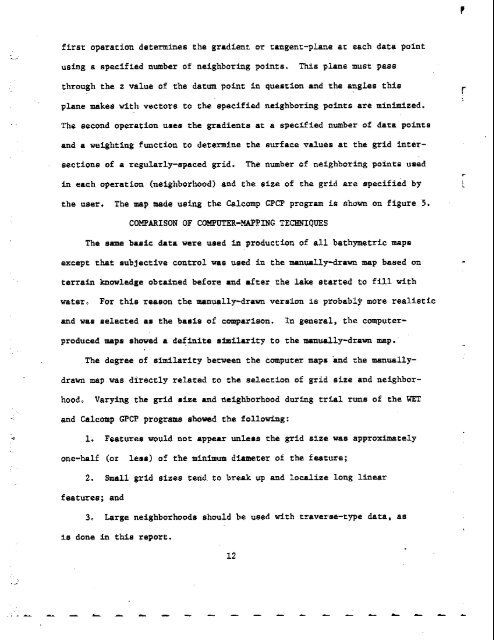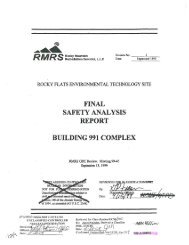Bathymetry of Cannikin Lake, Amchitka Island, Alaska, with
Bathymetry of Cannikin Lake, Amchitka Island, Alaska, with
Bathymetry of Cannikin Lake, Amchitka Island, Alaska, with
You also want an ePaper? Increase the reach of your titles
YUMPU automatically turns print PDFs into web optimized ePapers that Google loves.
....<br />
firer operation determinee the gradient or rangenr-plane ar: each date point<br />
using a specified number <strong>of</strong> neighboring points. This plane must pass<br />
through the z value <strong>of</strong> the datum point in quemtion and the angles this<br />
plane makes <strong>with</strong> vectors to the specified neighboring points are minimfeed.<br />
The second operation uaea the gradients at a specified number <strong>of</strong> data points<br />
and a weighting function to determine the surface values at the grid inter-<br />
sections <strong>of</strong> a regularly-spaced grid. The number <strong>of</strong> neighboring points uaed<br />
r<br />
in each operation (neighborhood) and the size <strong>of</strong> che grid are specified by L<br />
the user. The map made using the Calcomp GPCP program is shown on figure 5.<br />
COMPARISON OF COMPUTER-WP'ING TECHNIQUES<br />
The same baaic data were used in production <strong>of</strong> all bathymetric mapa<br />
except that subjective control was used in the enuaLly-dram map based on<br />
terrain knowledge obtained before and after the lake started to fill <strong>with</strong><br />
water, For this reason the manually-drawn version is probably more realistic<br />
and waa nelected as the basis <strong>of</strong> comparison. In general, the computer-<br />
produced mapa showed a definite similarity to the manually-dram map.<br />
The degree <strong>of</strong> similarity between the computer mapc ind rhe manually-<br />
drawn map was directly related to the selection <strong>of</strong> grid size and neighbor-<br />
hood, Varying the grid mize and deighborhood during trhl runs <strong>of</strong> the WET<br />
and Calcomp GPCP programs ahowed the followfng:<br />
1. Features would not appear unleas the grid sXze was approximately<br />
one-half (or lean) <strong>of</strong> the minimum diameter <strong>of</strong> the feature;<br />
2. Small grid sizes tend to break up and localize long linear<br />
features; and<br />
3. Large neighborhoods should be used <strong>with</strong> traverse-type data. as<br />
is done in this report.<br />
12<br />
r<br />
p
















